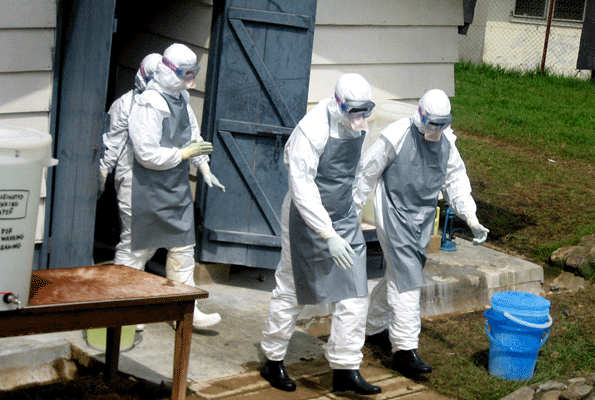Prime
Ebola: How Uganda handled past outbreaks

Health workers walk out of an Ebola isolation ward in Western Uganda in 2007.PHOTO/FILE
What you need to know:
- The government says it is ready to handle the outbreak.
With one confirmed death and seven deaths still under investigation, the country is experiencing its fifth outbreak of Ebola whose survival rate can be as low as 10 percent.
However, health specialists, who have been at the centre of combating the past outbreaks of Ebola and infectious diseases like Covid-19, project that the outbreak will be contained with low mortality.
Prof Pontiano Kaleebu, the director of Uganda Virus Research Institute (UVRI), and Dr Charles Njuguna, the head of public health emergencies at the World Health Organisation (WHO) Uganda office, said the country has gained experience and developed capacity over time to defeat epidemics.
“We have managed to combat Ebola in the past because of quick response,” Prof Kaleebu said. “Testing, epidemiology, and case management teams were on alert. We also worked with partners to help in the response.”
The country experienced outbreaks of Ebola Virus Disease (EVD) in 2000, 2014, 2017, and 2018, with the first outbreak claiming the highest number of lives, 224, according to information from the WHO. Between 2018 and 2019, the statistics from the government indicate that more than $20 million (Shs76 billion) was budgeted for Ebola outbreak in the country.
Dr Njuguna said although there are still gaps, the experience and structures the country developed as a result of the past response against the Ebola outbreak and even the Covid-19 pandemic, have made the country more prepared to respond to the outbreak.
“There is a lot of improvement in capacity to respond to emergencies but we cannot say we are there already. When we do assessments, we still see some gaps to address. When you are operationally ready, you are able to move quickly, deploy your human resource capacity, tackle the event and reduce mortality,” he said.
He added: “In every emergency, we usually look back on how we performed to be able to learn lessons from the previous lessons so you can address gaps. There is no one outbreak that you can say the health system functioned perfectly but there are a lot of strengths along the way.”
After gaining experience, Uganda, in 2014, sent 20 of its health experts to Sierra Leone and Liberia to help in containing the Ebola outbreak in the countries, an action which turned out successful amid the infection and death of at least one of the experts, according to media reports.
Dr Henry Kyobe, an epidemiologist at the Health ministry who is coordinating the response to the Ebola outbreak, said community engagement and strong leadership explain the past successes Uganda registered in combating Ebola and Covid-19.
He said informing the population about the disease, guiding them on the measures to be able to protect themselves and asking them to show their contacts have been key in controlling the epidemics.
The EVD is transmitted through the blood or fluids of an infected person and objects that have been contaminated with body fluids from an infected person. Human-to-human transmission of Ebola occurs via direct contact with the blood or body fluids of an infected person or a person who died of the disease. Touching objects contaminated with body fluids of an infected person is another way it is transmitted.
One can also contract the disease through contact with blood, secretions, organs or other bodily fluids of infected animals such as fruit bats and other wild animals.
The known symptoms of Ebola include high body temperatures, fatigue, chest pain, diarrhoea, vomiting, unexplained bleeding, and yellowing of the eyes. Bleeding is usually a late presentation after the above symptoms, according to the Health ministry.
The expert said even in this new outbreak, there is good corporation with the community.
“They are supportive. We are still very early in this outbreak, we have controlled it, there is no doubt. Remember we are within 48 hours of confirmation,” he said.
Information from the government indicates that at least three strains of Ebola have been developed. This includes Sudan, Bundibugyo and Zaire strains.
“Budibugyo strain was first detected in Uganda but the rest were first described in the respective countries. That the new outbreak could have been generated from within the country is speculation, but it is also possible until we have evidence,” Prof Kaleebu said.
“That is why we are still investigating. If these people didn’t travel, where does Ebola hide? In Uganda, we have isolated Marburg from the bat but for Ebola, it was isolated in animals in other countries,” he added.
Dr Kyobe said each outbreak is usually a different strain.
“We have had a circulation of three strains unlike other countries where only strain has circulated,” he said.
He said it has nothing to do with vigilance at border points.
Dr Kyobe said the virus can move from wild animals to humans, causing an outbreak.
Affected districts
Some of the districts that have been affected by Ebola include Gulu [and neighbouring districts], Kibale, Luweero, Bundibugyo, Kyegegwa, and Mubende, according to information from the Health Ministry. Uganda’s largest documented EVD outbreak occurred in 2000–2001 in Gulu District, registering 425 cases and 224 deaths, according to the Ministry.




